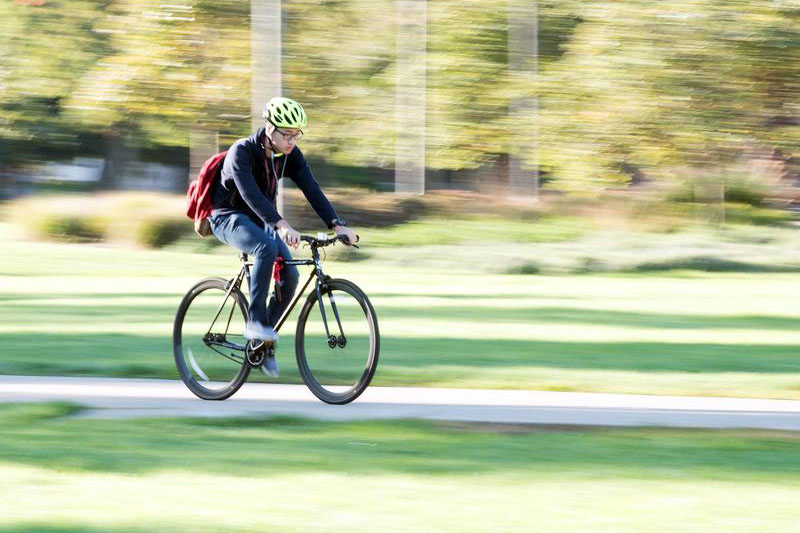Julia Andary had always ridden her bike to and from her undergraduate classes at Michigan State University. But she never realized how many students rode without helmets until she took a closer look.
Andary is among several MSU students who are leading the charge to increase bike helmet use on and off campus. Dubbed “Spartan Armor,” the initiative looks to prevent traumatic brain injuries and resulting cognitive communication disorders by encouraging people to wear helmets while riding their bikes or moped.
Andary was motivated to research bike helmet use by MSU students while taking a course for her CSD minor in communicative sciences and disorders through the College of Communication Arts and Sciences. A discussion on traumatic brain injury stuck with her, particularly when CSD Professor of Practice and Graduate Program Director Matt Phillips shared first-hand accounts from his clinical and hospital experience.
“I was specifically persuaded by hearing Matt discuss his days working in emergency care in a hospital and witnessing the differences between the severity of injury when a person wore a helmet or not,” says Andary. “I also realized that biking injuries can compromise a student’s ability to perform in school, and it was a frightening thought.”
Creating An Outreach Campaign
Andary graduated in the fall of 2017 with her bachelor’s in communication. She is returning in August to start her CSD master’s program. Her undergraduate research and resulting report provided the basis for Spartan Armor. Her comprehensive analysis inspired other undergraduates to join the effort, and to lay the groundwork for an ongoing outreach campaign.
One of those students was Ashley Kapuscinski, a recent communication graduate who is also coming back for her CSD master’s this fall. Kapuscinski was a classmate of Andary’s and had taken Phillip’s course at the same time. On the way to earning her CSD minor, the undergraduate had shadowed speech therapy sessions, where she observed the effects of brain trauma.
“The opportunity to educate students on the repercussions of mild to severe brain injuries was one I could not pass up,” says Kapuscinski. “I am very passionate about the topic and motivated to make a difference in my community.”
Kapuscinski helped move Spartan Armor from the idea stage to a mission-driven student organization. She will join Andary and Phillips when she returns to campus to help guide and advise the group.
Both Kapuscinski and Phillips were struck by Andary’s data that revealed close to 90 percent of MSU bike and moped riders don’t wear helmets. They were also surprised by the conflicting rationale people gave for not wearing the protective gear.
“The vast majority acknowledged the importance of wearing a helmet, but said they didn’t wear one because they perceive cycling on campus as safe,” Phillips says. “People also said they don’t wear helmets because they don’t look good. Many said they don’t wear helmets because they notice no one else is wearing them.”
Bike-friendly, does not equate to accident-free
Andary’s survey of police reports shows that 657 people were involved in 305 crashes on or close to the MSU campus in a five-year span. And when bike accidents occur, the most serious results are brain injury—something that can be prevented 8 out of 10 times by wearing a helmet. Andary concluded that an educational program, with incentives, could bring student behavior in line with their belief in the safety of helmet use.
Salma Martinez was among the half-dozen MSU students organizing Spartan Armor last spring. She will recruit others come fall. Plans include continued promotion through social media channels, enlisting sponsors and spokespeople, securing grants to purchase helmets, and recruiting bike-friendly businesses to incentivize helmet use.
“Ultimately, I hope to change perspectives and get more people to wear helmets on campus,” says the human development and family studies junior who has taken several CSD courses. “As a member of Spartan Armor, my role is to inform the MSU community of the important of protecting our brains by using proper headgear, and of the consequences that can follow when you don’t.”
The student-run Spartan Armor project is an outgrowth of initiatives within the MSU College of ComArtSci to pioneer interdisciplinary research that combines the field of communication science with cognitive neuroscience, psychophysiology, media psychology, neurolinguistics and neuromarketing. To learn more about how ComArtSci faculty and students are exploring neurocognitive communication, visit https://comartsci.msu.edu/neuro-comm.
By Ann Kammerer
